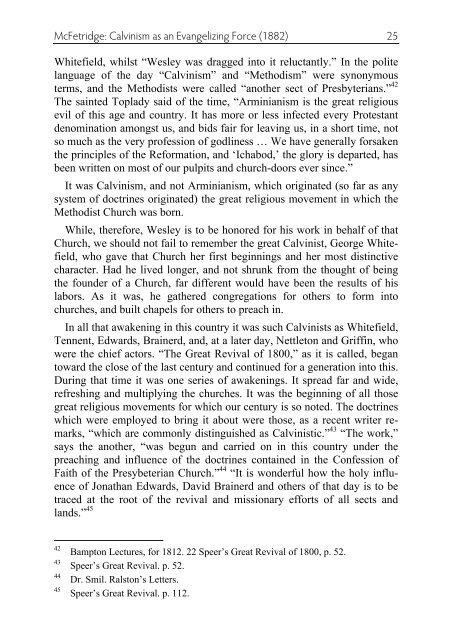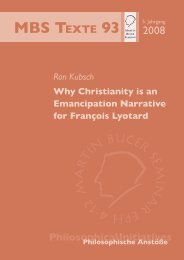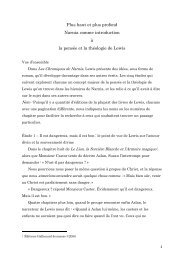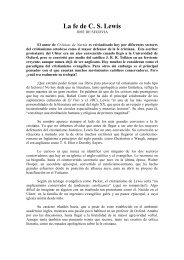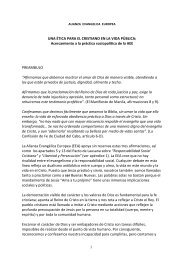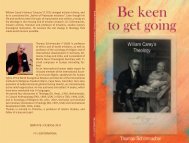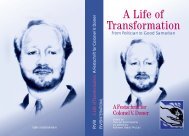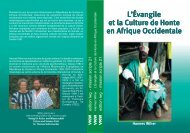Calvin and Missions - World Evangelical Alliance
Calvin and Missions - World Evangelical Alliance
Calvin and Missions - World Evangelical Alliance
You also want an ePaper? Increase the reach of your titles
YUMPU automatically turns print PDFs into web optimized ePapers that Google loves.
McFetridge: <strong>Calvin</strong>ism as an Evangelizing Force (1882) 25<br />
Whitefield, whilst “Wesley was dragged into it reluctantly.” In the polite<br />
language of the day “<strong>Calvin</strong>ism” <strong>and</strong> “Methodism” were synonymous<br />
terms, <strong>and</strong> the Methodists were called “another sect of Presbyterians.” 42<br />
The sainted Toplady said of the time, “Arminianism is the great religious<br />
evil of this age <strong>and</strong> country. It has more or less infected every Protestant<br />
denomination amongst us, <strong>and</strong> bids fair for leaving us, in a short time, not<br />
so much as the very profession of godliness … We have generally forsaken<br />
the principles of the Reformation, <strong>and</strong> ‘Ichabod,’ the glory is departed, has<br />
been written on most of our pulpits <strong>and</strong> church-doors ever since.”<br />
It was <strong>Calvin</strong>ism, <strong>and</strong> not Arminianism, which originated (so far as any<br />
system of doctrines originated) the great religious movement in which the<br />
Methodist Church was born.<br />
While, therefore, Wesley is to be honored for his work in behalf of that<br />
Church, we should not fail to remember the great <strong>Calvin</strong>ist, George Whitefield,<br />
who gave that Church her first beginnings <strong>and</strong> her most distinctive<br />
character. Had he lived longer, <strong>and</strong> not shrunk from the thought of being<br />
the founder of a Church, far different would have been the results of his<br />
labors. As it was, he gathered congregations for others to form into<br />
churches, <strong>and</strong> built chapels for others to preach in.<br />
In all that awakening in this country it was such <strong>Calvin</strong>ists as Whitefield,<br />
Tennent, Edwards, Brainerd, <strong>and</strong>, at a later day, Nettleton <strong>and</strong> Griffin, who<br />
were the chief actors. “The Great Revival of 1800,” as it is called, began<br />
toward the close of the last century <strong>and</strong> continued for a generation into this.<br />
During that time it was one series of awakenings. It spread far <strong>and</strong> wide,<br />
refreshing <strong>and</strong> multiplying the churches. It was the beginning of all those<br />
great religious movements for which our century is so noted. The doctrines<br />
which were employed to bring it about were those, as a recent writer remarks,<br />
“which are commonly distinguished as <strong>Calvin</strong>istic.” 43 “The work,”<br />
says the another, “was begun <strong>and</strong> carried on in this country under the<br />
preaching <strong>and</strong> influence of the doctrines contained in the Confession of<br />
Faith of the Presybeterian Church.” 44 “It is wonderful how the holy influence<br />
of Jonathan Edwards, David Brainerd <strong>and</strong> others of that day is to be<br />
traced at the root of the revival <strong>and</strong> missionary efforts of all sects <strong>and</strong><br />
l<strong>and</strong>s.” 45<br />
42 Bampton Lectures, for 1812. 22 Speer’s Great Revival of 1800, p. 52.<br />
43 Speer’s Great Revival. p. 52.<br />
44 Dr. Smil. Ralston’s Letters.<br />
45 Speer’s Great Revival. p. 112.


